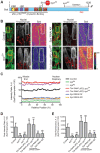Syd/JIP3 and JNK signaling are required for myonuclear positioning and muscle function
- PMID: 25522254
- PMCID: PMC4270490
- DOI: 10.1371/journal.pgen.1004880
Syd/JIP3 and JNK signaling are required for myonuclear positioning and muscle function
Abstract
Highlighting the importance of proper intracellular organization, many muscle diseases are characterized by mispositioned myonuclei. Proper positioning of myonuclei is dependent upon the microtubule motor proteins, Kinesin-1 and cytoplasmic Dynein, and there are at least two distinct mechanisms by which Kinesin and Dynein move myonuclei. The motors exert forces both directly on the nuclear surface and from the cell cortex via microtubules. How these activities are spatially segregated yet coordinated to position myonuclei is unknown. Using Drosophila melanogaster, we identified that Sunday Driver (Syd), a homolog of mammalian JNK-interacting protein 3 (JIP3), specifically regulates Kinesin- and Dynein-dependent cortical pulling of myonuclei without affecting motor activity near the nucleus. Specifically, Syd mediates Kinesin-dependent localization of Dynein to the muscle ends, where cortically anchored Dynein then pulls microtubules and the attached myonuclei into place. Proper localization of Dynein also requires activation of the JNK signaling cascade. Furthermore, Syd functions downstream of JNK signaling because without Syd, JNK signaling is insufficient to promote Kinesin-dependent localization of Dynein to the muscle ends. The significance of Syd-dependent myonuclear positioning is illustrated by muscle-specific depletion of Syd, which impairs muscle function. Moreover, both myonuclear spacing and locomotive defects in syd mutants can be rescued by expression of mammalian JIP3 in Drosophila muscle tissue, indicating an evolutionarily conserved role for JIP3 in myonuclear movement and highlighting the utility of Drosophila as a model for studying mammalian development. Collectively, we implicate Syd/JIP3 as a novel regulator of myogenesis that is required for proper intracellular organization and tissue function.
Conflict of interest statement
The authors have declared that no competing interests exist.
Figures








References
Publication types
MeSH terms
Substances
Grants and funding
LinkOut - more resources
Full Text Sources
Other Literature Sources
Molecular Biology Databases
Research Materials

